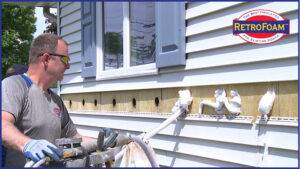Are you considering upgrading your home insulation in Cincinnati? Injection foam insulation could be the right choice. Injection foam insulation is an efficient method of insulating both new and old houses. But what exactly is this type of insulation, and why is it gaining popularity in Cincinnati?
Introduction to Cincinnati Injection Foam Insulation
Injection foam insulation has become an increasingly popular option for homeowners and builders in Cincinnati looking to improve energy efficiency, comfort, and noise reduction in their homes and buildings. This type of insulation works by injecting polyurethane or other liquid foam materials into wall cavities, attics, crawl spaces, and other areas that need insulation.
Unlike spray foam insulation, injection foam does not expand significantly upon application. It simply displaces the air and fills the full cavity, solidifying into a dense foam over time. This allows it to provide insulation and an air seal by eliminating gaps and pockets of air within the cavity. The liquid foam molds perfectly to the specific shape and depth of the cavity for complete filling. The cured solid foam then resists conduction and convection to form an effective thermal barrier.
For Cincinnati in particular, injection foam insulation offers important benefits given the city’s climate extremes. Cincinnati winters can get quite cold, with average lows in the 20s Fahrenheit from December to February. Summers are hot and humid, with temperatures frequently in the 80s and 90s Fahrenheit from June to August. This wide range of temperatures means homes need effective insulation to stay warm in winter and cool in summer. Injection foam can provide the insulation performance that Cincinnati needs.
Defining Injection Foam Insulation
Injection foam insulation refers to a polyurethane or resin-based foam that is injected as a liquid which then cures and hardens in place. Unlike spray foam insulation that expands significantly, injection foam does not expand in volume much after being injected. It simply displaces the air and hardens to the shape of the cavity or space being filled. The cured foam provides insulation and an air barrier with its dense closed-cell structure.
Why It’s Relevant in Cincinnati
There are several reasons why injection foam insulation is especially relevant for homes and buildings in the Cincinnati area:
- Climate extremes: As mentioned, Cincinnati has cold winters and hot summers, making insulation critical for comfort and energy savings. Injection foam can insulate well year-round.
- Older housing stock: Over 60% of homes in Cincinnati were built before 1980, prior to modern insulation standards. Injecting foam is an effective way to upgrade and fill gaps in insulation.
- High energy costs: Cincinnati residents pay over 10% more than the U.S. average for electricity. Foam insulation helps reduce high energy bills.
- Humidity: Cincinnati summers are humid, resulting in condensation and mildew risks. The closed-cell foam keeps out moisture.
- Noise: Between the airport and highways, Cincinnati can be noisy. Foam insulation helps block exterior sounds.
Overall, injection foam insulation offers important benefits tailored to Cincinnati’s climate, buildings, energy costs, and noise issues.
Understanding How Injection Foam Insulation Works
To understand why injection foam is an effective insulating solution, it helps to look at how it is installed and its key properties.
Installation Process
Injection foam insulation is installed by professional installers using special equipment. The process typically involves:
- Evaluating the areas that require insulation.
- Drilling small holes to access those areas (e.g. in existing walls).
- Inserting hoses and nozzles into the holes.
- Mixing the liquid chemical components that react to create foam.
- Injecting the foam through the hoses so it fully fills the cavity.
- Patching the holes.
The foam fills all nooks, gaps, and spaces as it cures.
Heat Retention Mechanism
Injection foam insulation retains heat through its dense, closed-cell structure. Unlike spray foam, it does not have an expanded cellular configuration with gas-filled cells. The solidified injection foam is uniform and consistent rather than porous. This solid foam mass resists heat transfer through conduction and convection. There is no space for air currents to move through it, carrying heat. The foam also eliminates gaps and air pockets within wall cavities, allowing hot or cold air to transfer in and out. This air sealing and thermal resistance combination allows injection foam to insulate homes effectively.
Sound Absorption Attributes
Injection foam insulation also has excellent sound-dampening properties. The dense cell structure absorbs sound waves rather than transmitting them. By filling wall cavities completely, the foam reduces exterior noise transmission into living spaces. This additional benefit makes homes noticeably quieter.
Advantages of Injection Foam Insulation
Compared to other types of insulation like fiberglass batts, injection foam insulation offers several notable benefits:
Energy Efficiency
The biggest advantage of injection foam insulation is the excellent air sealing it provides. Gaps and cracks in wall cavities allow conditioned air to escape, wasting energy. Because injection foam fills the entire cavity and molds to its precise shape, it eliminates these gaps that allow air leakage.
Unlike spray foam, injection foam does not expand significantly or need to adhere to surfaces. It simply displaces air and hardens within the cavity. This completely fills any spaces and cracks that allow air flow.
Comfort and Noise Reduction
By preventing drafts and regulating temperatures, closed-cell foam allows homeowners to feel more comfortable throughout the year. No longer will certain rooms or whole floors feel drastically hotter or colder than the rest of the home. The insulation also absorbs noises from the outside, making indoor spaces more peaceful.
Long-lasting Effects
Once properly installed, injection foam insulation provides long-lasting benefits without needing replacement. The dense foam does not degrade or shift over time. It maintains its rigid structure within the wall cavities or spaces it was injected into. This allows the air sealing properties to remain intact long-term, stopping energy loss through gaps and cracks.
The foam insulation resists conduction and convection steadily over decades. While not quite as rigid initially as spray foam, high-quality injection foam insulation will provide lasting insulation, efficiency, and noise reduction for homes.
Factors to Consider When Opting for Injection Foam Insulation
While injection foam insulation has many benefits for Cincinnati homes and buildings, it is not necessarily the best choice every time. Some factors to consider include:
Building Type and Structure
Foam insulation works well for standard wood-frame construction. However, the injection method is not suitable for unenclosed spaces like attics with roof rafters exposed. Other insulation materials like spray foam may be better for these areas.
Cost and Budget Considerations
Injection foam is costlier upfront than basic batt insulation. However, factored over the long term, the energy savings can make it worthwhile. Each building’s needs should determine whether the extra cost is justified.
Conclusion: Making Your Home More Energy-Efficient with Injection Foam Insulation
For many Cincinnati homeowners, RetroFoam insulation is an ideal solution for insulating against the city’s temperature extremes while reducing noise and improving comfort. This type of insulation outperforms traditional materials by sealing air spaces completely to prevent energy loss and heat transfer.
Key benefits of injection foam include energy savings, consistent temperatures, sound dampening, moisture resistance, and durability over time. While weighing installation costs, injection foam insulation remains one of the most effective ways to increase efficiency and make Cincinnati buildings more liveable year-round. With energy prices high and winter cold, insulating with injection foam can be a wise investment.
Trust Cincinnati RetroFoam for Injection Foam Insulation
When it comes to installing injection foam insulation in Cincinnati homes and buildings, there’s one company you can trust – Cincinnati RetroFoam.
As a local company rooted right here in Cincinnati, RetroFoam understands our climate, older housing stock, and the benefits injection foam can offer. We offer top-quality injection foam to match your project. This leads to optimal energy efficiency and comfort improvements.
From start to finish, you can rely on our team of seasoned professionals to implement injection foam insulation right. We take care of assessing your existing insulation, determining ideal injection points, installing the foam throughout cavities, and neatly patching all holes.
If you’re looking to upgrade your home’s insulation with injection foam, look no further than the experts at Cincinnati RetroFoam. Our tailored solutions, outstanding service, and results you can count on make us the smart choice for injection foam insulation in Cincinnati.
FAQs
Does insurance cover injection foam insulation?
Some insurance companies offer green upgrade discounts or credits that could help cover insulation costs. Shop around to find the best home insurance options.
Is spray foam toxic?
Installers should wear proper protective gear when applying spray insulation. Once cured, closed-cell SPF is considered inert and non-toxic per EPA guidelines. Off-gassing is minimal and the foam is sealed within walls. (RetroFoam does not off-gas, is Class One Fire Rated, and is environmentally friendly.)
